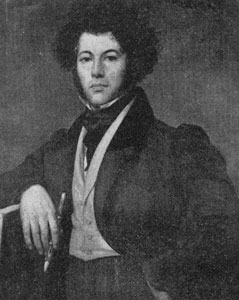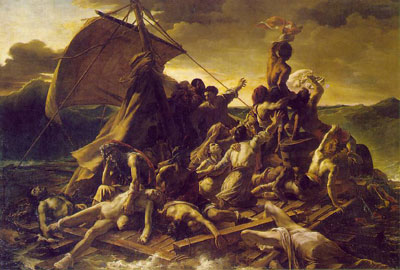| Exhibition | The project | Paintings | Drawings | Artist book | Sculptures | Other works | Biographies | Contact | Links |
thanks to: http://www.wga.hu/frames-e.html?/html/g/gericaul/1/105geric.html
|
|
|
In expressing the predicament of the shipwrecked
everywhere in the world, Géricault had laid the foundations
of an aesthetic revolution. The Raft of the Medusa marks the first
appearance in painting of 'the ugly' and thereby proclaims its
scrupulous respect for the truth, however repulsive the truth might
be. This concern for truth is integral to the Romantic temperament.
For his Salon picture in 1819, Géricault chose a dramatic episode — the wreck of the frigate Meduse, which had set off with a French fleet on an expedition to Senegal, and had been lost in July 1816. The French admiralty was accused of having put an incompetent officer in charge of the expedition; he was the Comte de Chaumareix, a former emigre who had not commanded a vessel for twenty-five years. The picture was an enormous success, more on account of the scandal than because of an interest in the arts; but Géricault only received a gold medal, and his picture was not bought by the government. One wonders who it was suggested commissioning this painter of horror subjects to do a Sacred Heart.
Géricault was mortified, and decided to exhibit his picture in England, where a pamphlet had been published on the wreck of the Meduse. He entrusted the vast canvas to an eccentric character named Bullock (as Lethière had done with his Brutus Condemning his Sons), and it was exhibited in London from 12 June to 31 December 1820, and in Dublin from 5 February to 31 March 1821. Géricault received a third of the takings, and the operation brought him in quite a large sum (probably 20,000 francs).
The painting was priced at 6,000 francs at the posthumous sale of the artist's possessions. It was bought by Dedreux-Dorcy, a friend of Géricault, for an additional five francs, and he sold it to the State for the same amount.
The most horrifying part of the shipwreck had been the drama of 149 wretches abandoned on a raft with only some casks of wine to live on, and the ensuing drunkenness and abominations. When the frigate Argus found the raft, after many days, she was only able to rescue fifteen survivors, of whom five died after being brought ashore. After some hesitation, Géricault chose this last episode — the sighting of the Argus by the survivors on the raft. With regard to the latter, he set himself to the task of carrying out an inquest as thoroughly as any examining magistrate. He rented a studio opposite the Beaujon hospital, so that he could make anatomical studies of the dying.
The picture was painted by Géricault in an extraordinary state of tension; 'the mere sound of a smile prevented him from painting'.
Biography

French
painter, one of the prime movers and most original figures of Romanticism.
He studied in Paris with Carle Vernet and Pierre Guérin,
but was influenced more by making copies of the Old Masters at
the Louvre, developing in particular a passion for Rubens. In
1816-17 he was in Italy and there became an enthusiastic admirer
of Michelangelo and
the Baroque.
His ambitions as a history painter were frustrated by a lack of grand national themes after the fall of Napoleon, and he turned to a more subversive analysis of contemporary events. On his return to Paris he exhibited the picture for which he is most famous, The Raft of the Medusa (Louvre, Paris, 1819), which although it was awarded a medal at the Salon, created a furore both on account of its realistic treatment of a horrific event and because of its political implications (it depicts the ordeal of the survivors of the shipwreck of the Medusa in 1816, a disaster ascribed by some to government incompetence). The picture, which was remarkably original in treating a contemporary event with epic grandeur, also had a 'succes de scandale' in England, where Géricault spent the years 1820-22. He painted jockeys and horse races ( Derby at Epson, Louvre, 1821) and was one of the first to introduce English painting to the notice of French artists (he was particularly enthusiastic about Constable and Bonington).
Géricault was a passionate horseman and his death at the age of 33 was brought on by a riding accident. In his temperament and lifestyle as well as his work he ranks (like Byron, for example) as an archetypal Romantic artist. His tempestuous career lasted little more than a decade and in that time he displayed a meteoric and many-sided genius. His love of stirring action, his sense of swirling movement, his energetic handling of paint, and his taste for the macabre were all to become features of Romanticism. He was, at the same time forward-looking in his realism: he made studies from corpses and severed limbs for The Raft of the Medusa and painted an extraordinary series of portraits of mental patients in the clinic of his friend Dr Georget, one of the pioneers of humane treatment for the insane (A Kleptomaniac, Musée des Beaux-Arts, Ghent, c. 1822-23). His work had enormous influence, most notably on Delacroix.

